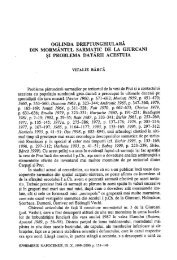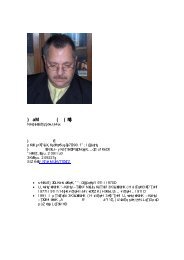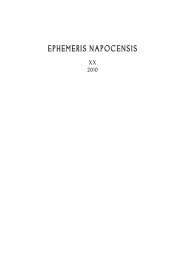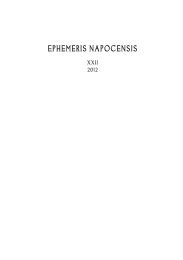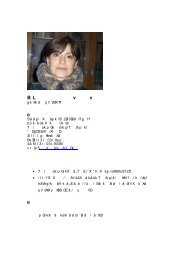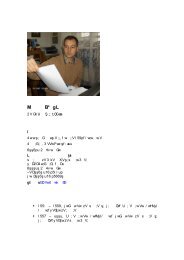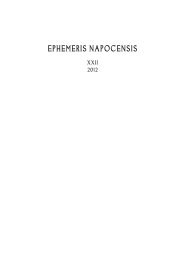ephemeris napocensis 2011 cu corectura.indd - Institutul de ...
ephemeris napocensis 2011 cu corectura.indd - Institutul de ...
ephemeris napocensis 2011 cu corectura.indd - Institutul de ...
Create successful ePaper yourself
Turn your PDF publications into a flip-book with our unique Google optimized e-Paper software.
120 Monica Guito surgeons (e.g. the handle from Gilău was <strong>de</strong>corated with silver inlay). This is probably alsotrue for some small knives found at Porolissum-Pomet 60 (Pl. I/3). More numerous are theforceps tweezers 61 , which were used for extracting foreign bodies, holding and lifting skin ortissue etc. 62 The forceps consi<strong>de</strong>red are of the pointed-jawed (Pl. I/7), smooth-jawed (Pl. I/6)or toothed-jawed types and some have sli<strong>de</strong>-rings for fixation.One pair is of a rarer type, beingcombined with a scoop probe 63 (Pl. I/8). Another double forceps with interlocking teeth andsli<strong>de</strong>-ring has been discovered in the legionary fortress of trajanic date at Berzobis (Caraș-Severincounty), this one ending with a blunt hook 64 . Sharp hooks were used as retractors for woundsand incisions, being essential to the surgeon 65 . Although common in the rest of the Empire, onlyone has been published from the military sites in Dacia 66 (Pl. I/4).The presence of a physicianor a pharmacist is suggested by a fragment of a cylindrical copper alloy box found at Bologa 67(Pl. I/10), of the type used to store probes and needles or collyria 68 . Another find from the samefort is a tuff palette with the name Denecio scratched on the back; this person was consi<strong>de</strong>reda military o<strong>cu</strong>list 69 , but the writing might as well relate to the owner. It seems that during theexcavations in the fort of Drobeta, a surgical set turned up 70 , but to my knowledge the pieceshaven’t been published.Archaeological discoveries from different parts of the Empire show that a simple toiletset was basically ma<strong>de</strong> up of a pair of tweezers and an ear pick (ligula probe), sometimes a nailcleaner 71 . Most of the so-called ‘medical instruments’ from the Roman forts of Dacia are exactlytweezers and various types of probes, so at least some could actually be toiletry.Several cosmetic tweezers (with a length of less than 10 cm) have been found 72 . Themajority are extremely simple, ma<strong>de</strong> of a single strip of metal. It should be noted that these werealso commonly used in the household, as lamp accessories for putting out the fire or handlingthe wick 73 . By far, the largest in numbers are the different kinds of probes and spatulas. Thesetoo could be employed in all sorts of activities that have nothing to do with medicine or hygiene,like mixing paints or <strong>de</strong>corating ceramic vessels, as seen in a potter’s workshop from the ruralsettlement of Micăsasa 74 .The ear probe 75 (specillum ori<strong>cu</strong>larium or ligula), a slen<strong>de</strong>r stem endingwith a small angled plate, was used for medical investigations as well as for extracting cosmetics60GUDEA/BAJUSZ 1992, 254, nos. 6–8, Pl. I/6–8.61GUDEA/BAJUSZ 1992, 259, nos. 13–14, Pl. V/13, 14 (Buciumi); nos. 1–2, Pl. VI/1, 2 (Porolissum-Pomet); COCIȘ 1993, 241, no. 1, Fig. 1/1 = PROTASE/GUDEA/ARDEVAN 2008, 88, no.1, Pl. XLII/1 (Gherla).62JACKSON 1986, 137–139; JACKSON <strong>2011</strong>, 254–255.63GUDEA/BAJUSZ 1992, 259, no. 2, Pl. VI/2.64FLUTUR/FLUTUR 2007, 75–76, Pl. I, II.65JACKSON 1986, 139; JACKSON <strong>2011</strong>, 256; MILNE 1907, 85–87.66GUDEA/BAJUSZ 1992, 259, no. 3, Pl. VI/3 (Porolissum-Pomet).67GUDEA/BAJUSZ 1992, 264, no. 7, Pl. X/7.68KÜNZL 1984, 166; JACKSON 1986, 137, Fig. 5/36, 37; MILNE 1907, 169–171, Pl. LIII.69GUDEA 1997b, 60.70BENEA 1975, 306.71CRUMMY 1983, 61–62, nos. 141–145, Fig. 67 (Colchester); RIHA 1986, 26, Pl. 9/71–73 (AugustaRaurica); another such set is illustrated by MILNE 1907, Pl. XXVI/4; though the nail cleaners are typically Romano-British.72POP 1997, 36, no. 217 (Ilișua); GUDEA/BAJUSZ 1992, 258–259, nos. 2, 10, 12, Pl. V/2, 10, 12 (Buciumi);258, nos. 4, 6, 7, Pl. V/4, 6, 7 (Porolissum-Pomet); DIACONESCU/OPREANU 1987, 59, no. 22, Fig. 3/22(Gilău); BONDOC/GUDEA 2009, 234, nos. 739–740, Pl. CXIX/739 (Răcari).73ALICU/COCIȘ 1989, 226; MILNE 1907, 92.74ALICU/COCIȘ 1989, 223.75GUDEA/BAJUSZ 1992, 261, nos. 2, 7, Pl. VIII/2, 7 (Porolissum-Pomet); 261, no. 3, Pl. VIII/3 (Buciumi);BĂRBULESCU 1997, Fig. 26/5 (Potaissa).



